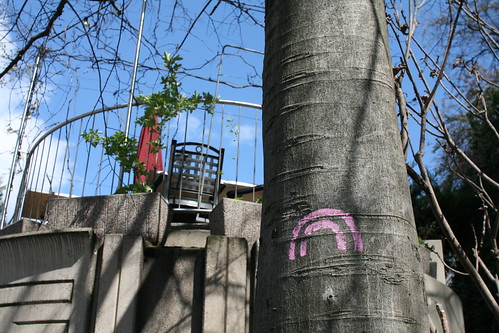 (presence of wifi in Geneva, revealed on a tree)
(presence of wifi in Geneva, revealed on a tree)
My interest in the invisibility of the digital (on par with its pervasiveness in the physical) led me to Katrina Jungnickel's research project called Making Wifi. Her work basically explores the role and importance of visual representations and practices in the making of a new digital technology: Wireless Fidelity (WiFi):
"Drawing on an ethnography (participant observation and interviews) of the largest not-for-profit volunteer community WiFi network in Australia, she examines how members design, make, tinker, break, fix and share a wireless network that spans across the city of Adelaide. To do this she foregrounds the visual representations members make in everyday situated practice and examine what types of work they do. She shows how members regularly encounter trees, thieves, animals, neighbours, legal restrictions, technical complications, a myriad of materials and the weather in the daily practice of making WiFi. However, rather than filtering out and tidying up mundane mess, members build it into their visual practices. They make WiFi because of uncertainty and ambiguity, not in spite of it."
More specifically, she is interested in DIY as well as the role of mess as a conduit to new forms of expression and innovation:
"One thing I’m currently exploring is the paradox implicit in DIY WiFi. If WiFi is an invisible, fragile, temperamental and complicated technology that predicates meticulous precision, advanced technical skills and abstract diagrammatic schema then what constitutes DIY or "homebrew" high tech? How do members negotiate the intersection of wireless technology and tinkering? What is the role of hands-on knowledge in making, understanding and innovating and how, if at all, does a hands-on engagement influence their relationship to the technology and the network as a whole?"
More on her research blog Why do I blog this? it seems a relevant exploration of intriguing DIY practices as well as situated practice regarding technological development, always good to read/investigate to understand the complexity of technology and how it is hybridized with other elements (be they legal restrictions or the presence of animal). Would be nice to read the whole phd or papers. Personally, it's in this sort of research that I like reading thick description of how design and usage, the kind of material I like skimming as case studies of "messy" innovation.